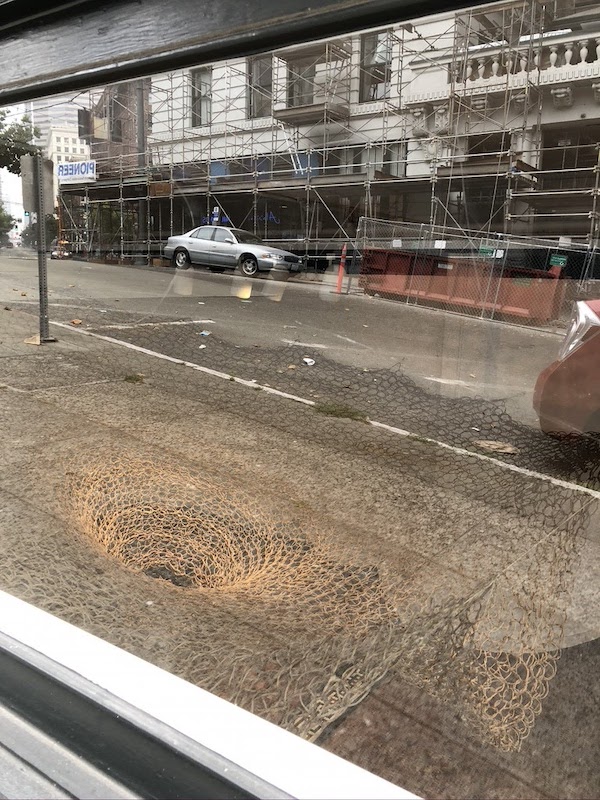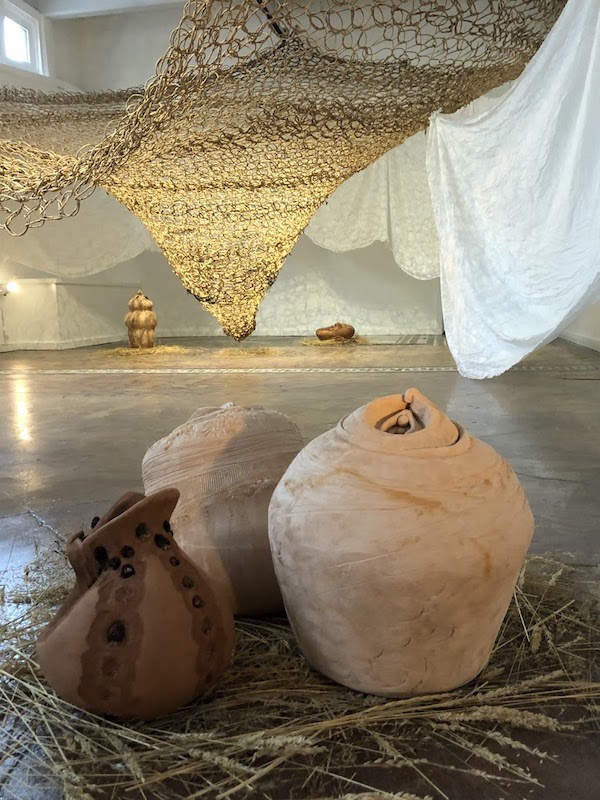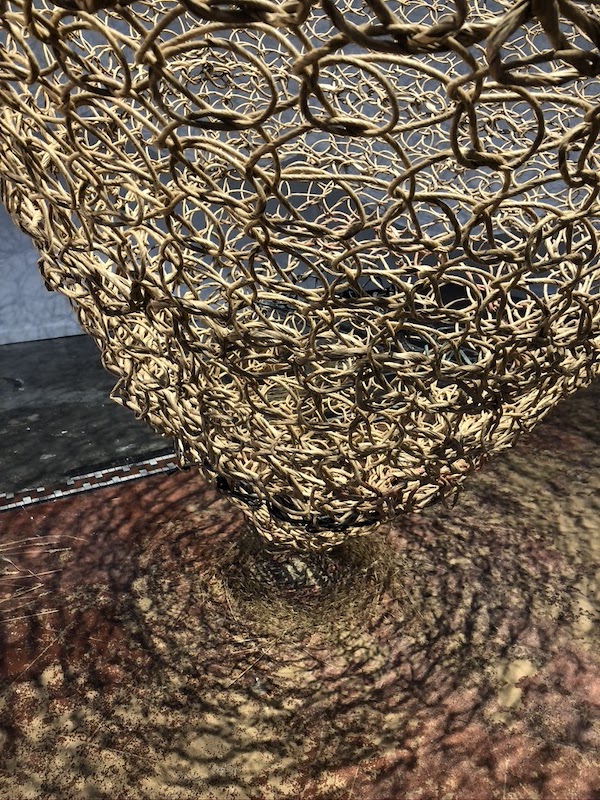Hanako O’Leary’s Yomi, METHOD Gallery, and Pioneer Square
Kati Simek
My first impression of Yomi was through a ground-level window as I approached the gallery from the bus stop. I was actually startled, disoriented by the juxtaposition of the reflection in the window with the portal-like hanging inside at my feet. When viewed from above, the huge roll of hand-woven jute had a hypnotic, disorientating effect, much like black and white spiral illustrations or a large winding staircase might. I got the sensation I might fall through and get stuck, as if in a fish trap.

Outside, Pioneer Square was buzzing with sounds of traffic and construction, even though crowds were thinner than they might usually be. No doubt the lingering smoke from regional wildfires had kept some people indoors; that and the pandemic going on. I took the bus because fares were still free, masks and social distancing measures in place. I cringed at the cliché of “the new normal.” It was noon on a Friday in September 2020, six months into a ban on large gatherings. I was meeting a classmate who had made the reservations necessary for us to see Hanako O’Leary’s installation at METHOD Gallery.
The gallery is nestled into Seattle’s first neighborhood, in a building dating back to 1907 that is now home to galleries, bookstores and artists’ lofts. The sidewalks outside have purple glass tiles embedded that bring up memories of history lessons and old photographs. There was a great fire. Pioneer Square and Downtown were subsequently regraded with fire hoses and dirt from neighboring hills, and afterward sat a full story higher. Ground floors became basements, and skylights became sidewalks. Concurrent with its rich history and culture, Pioneer Square is home to a number of people who sleep on those sidewalks, and I couldn’t help but question the connection between the neighborhood and those neighbors.
Inside I was offered another orientation and perspective to the neighborhood as Paula Stokes provided context to the piece, as well as the gallery itself. She is one of the co- founders of METHOD Gallery, which opened seven years ago, and is one of the volunteers that runs the space today. The gallery is 100% volunteer artist-run, and they have an operations budget of only $15,000 annually, most of which goes to rent. They offer exhibition space to visual artists for 7 weeks or so at a time, at times with a live performance component. Yomi is scheduled through Oct. 17.

The small corner unit that METHOD occupies has asymmetrical, street-level windows along one wall that provide natural light, supplementing the gallery lighting inside. The result is a fascinating array of textures and shadows that change depending on the conditions outside and throughout the day. Paula said they even keep the lights on at night, so passers by can appreciate the space from outside.
The focal point of Hanako O’Leary’s piece is the massive article of hand crocheted jute, an organic grass-like material. It is surrounded on three sides by draped white linen, and nestled on the floor among beds of grain on the old marketplace tiles are the artist’s air dried, handmade pottery. The vessels are hand-crafted using patterns taken from around O’Leary’s Rainier Valley home and feminine imagery. “Orifices everywhere!” remarked Stokes.
Interaction with the exhibit was encouraged by the artist and gallery alike, and getting up close intensified the impact of the work. The jute smells like straw, and they clay earthen. The loops that made up the centerpiece were large enough to slip your hand through to the wrist, and I thought again of woven fish traps. We learned that it had been hung completely differently at an outdoor showing previously, upside down relative to how it hung presently. I wondered if the intent was to create a portal to the underworld or heavens, or both depending on context.

Needless to say, the Covid-19 pandemic has forced METHOD Gallery to adapt to unusual circumstances. Paula Stokes described technical challenges, temporary closures, and modified public arts events. The gallery always had limited public access, being open only on Fridays, Saturdays, and First Thursdays, but now they were taking additional precautions, including allowing visitors by reservation only. Their online presence and archive has grown though, facilitating access. First Thursdays and Seattle Arts Fair have become online events. Fewer in-person visitors, according to Stokes, meant that attendees had a vested interest in the work, rather than in the social elements of an opening.
The relationship between METHOD Gallery and Pioneer Square is as complicated and layered as the neighborhood itself, and it’s a fitting setting for the installation of Hanako O’Leary’s Yomi. Access to the gallery space is limited, and covid restrictions are in place. They’re open Fridays and Saturdays, noon-4pm, and visits can be scheduled online. No reservation is required to enjoy the art from outside though, and the lights are on all night.